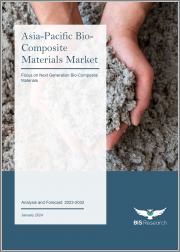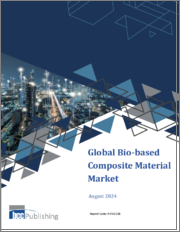
|
시장보고서
상품코드
1403554
아시아태평양의 바이오 복합재료 시장 : 분석 및 예측(2023-2032년)Asia-Pacific Bio-Composite Materials Market: Analysis and Forecast, 2023-2032 |
||||||
아시아태평양의 바이오 복합재 시장 규모(중국 제외)는 2023년 41억 6,000만 달러로 평가되었고, 향후 17.83%의 연평균 복합 성장률(CAGR)로 확대되어 2032년에는 182억 3,000만 달러에 달할 것으로 전망됩니다.
아시아태평양의 바이오 복합소재 시장은 자동차, 건설, 포장, 소비재 등 다양한 산업에서 친환경 생분해성 소재에 대한 인식과 채택이 증가함에 따라 여러 가지 요인에 의해 성장할 것으로 예상됩니다.
| 주요 시장 통계 | |
|---|---|
| 예측 기간 | 2023년-2032년 |
| 2023년 평가액 | 41억 6,000만 달러 |
| 2032년 전망 | 182억 3,000만 달러 |
| CAGR | 17.83% |
아시아태평양의 바이오 복합재료 시장은 성장 단계에 있으며, 바이오 복합재료를 제공하는 기업이 급증하고 있습니다. 천연섬유 및 목재 섬유와 같은 바이오 복합재료의 최근 기술 발전, 건설 프로젝트 증가, 자동차 산업, 재생 가능 에너지 수요, 전자 및 소비재 분야 등이 바이오 복합재료의 세계 채택을 촉진하고 있습니다. 또한, 친환경적이고 지속 가능한 소재에 대한 수요가 증가함에 따라 많은 업계 관계자들이 바이오 복합재 시장의 미래에 대한 기대감을 높이고 있습니다. 친환경 소재에 대한 세계 투자 증가는 주로 낮은 환경 영향과 비용 효율성에 기인합니다. 또한, 바이오 복합재료는 지속가능성과 성능 면에서 기존 대체재를 능가할 수 있는 잠재력을 가지고 있습니다.
본 보고서는 아시아태평양의 바이오 복합재료 시장을 조사했으며, 시장 개요와 함께 용도별/재료별/제품별/가공 기술별/국가별 동향, 시장 진출기업 프로파일 등을 정리하여 전해드립니다.
목차
주요 요약
조사 범위
제1장 시장
- 업계 전망
- 비즈니스 역학
- 비즈니스 촉진요인
- 비즈니스 억제요인
- 사업 전략
- 경영전략
- 비즈니스 기회
제2장 지역
- 중국
- 아시아태평양과 일본
제3장 시장 - 경쟁 벤치마킹과 기업 개요
- 경쟁 벤치마킹
- 경쟁 지위 매트릭스
- 주요 기업의 제품 매트릭스(재료 유형별)
- 기업 개요
- Anhui Guofeng Wood-Plastic Composite Co., Ltd
- Nanjing Xuhua Sundi New Building Materials Co., Ltd
제4장 조사 방법
LSH 24.01.17“The Asia-Pacific Bio-Composite Materials Market (excluding China) Expected to Reach $18.23 Billion by 2032.”
Introduction to Asia-Pacific (APAC) Bio-Composite Materials Market
The Asia-Pacific bio-composite materials market (excluding China) was valued at $4.16 billion in 2023, and it is expected to grow at a CAGR of 17.83% and reach $18.23 billion by 2032. The Asia-Pacific bio-composite materials market is expected to grow due to a number of factors, the most important of which is rising awareness and adoption of eco-friendly and biodegradable materials in a variety of industries, including automotive, construction, packaging, and consumer goods, among others.
| KEY MARKET STATISTICS | |
|---|---|
| Forecast Period | 2023 - 2032 |
| 2023 Evaluation | $4.16 Billion |
| 2032 Forecast | $18.23 Billion |
| CAGR | 17.83% |
Market Introduction
The Asia-Pacific bio-composite materials market is in a growing phase, with a rapid increase in the number of companies offering bio-composite materials. Recent technological advancements in bio-composite materials, such as natural fibers and wood fibers, as well as an increasing number of construction projects, the automotive industry, renewable energy demand, and the electronics and consumer goods sectors, are driving the global adoption of bio-composite materials. Furthermore, due to the increasing demand for environmentally friendly and sustainable materials, many industry players are looking forward to the future of the bio-composite materials market. The increased global investment in eco-friendly materials is being driven primarily by their low environmental impact and cost-effectiveness. Furthermore, bio-composite materials have the potential to outperform traditional alternatives in terms of sustainability and performance.
Market Segmentation:
Segmentation 1: by Application
- Automotive
- Construction
- Aerospace
- Consumer Goods
- Packaging
- Electronics
- Renewable Energy
- Others
Segmentation 2: by Material Type
- Natural Fibers
- Wood Fibers
- Bio-Polymers
- Next-Generation Materials
- Recycled Materials
- Synthetic Polymers
- Others
Segmentation 3: by Product Type
- Green Composites
- Hybrid Composites
Segmentation 4: by Processing Technique
- Compression Molding
- Injection Molding
- Resin Transfer Molding
- Extrusion
- Others
Segmentation 5: by Country
- Japan
- South Korea
- India
- Rest-of-Asia-Pacific and Japan
How can this report add value to an organization?
Product/Innovation Strategy: The product segment helps the reader to understand the different types involved in the Asia-Pacific bio-composite materials market. Moreover, the study provides the reader with a detailed understanding of the Asia-Pacific bio-composite materials market based on the application (automotive, construction, aerospace, consumer goods, packaging, electronics, renewable energy, and others). The bio-composite materials market is gaining traction in applications on the back of sustainability concerns and their higher tensile strength and toughness, among others. Bio-composite materials are also being used for controlling greenhouse gas (GHG) emissions. Moreover, partnerships and collaborations are expected to play a crucial role in strengthening market position over the coming years, with the companies focusing on bolstering their technological capabilities and gaining a dominant market share in the bio-composite materials industry.
Growth/Marketing Strategy: The Asia-Pacific bio-composite materials market has been growing at a rapid pace. The market offers enormous opportunities for existing and emerging market players. Some of the strategies covered in this segment are mergers and acquisitions, product launches, partnerships and collaborations, business expansions, and investments. The strategies preferred by companies to maintain and strengthen their market position primarily include partnerships, agreements, and collaborations.
Competitive Strategy: The key players in the Asia-Pacific bio-composite materials market analyzed and profiled in the study include bio-composite materials suppliers that develop, maintain, and market bio-composite materials. Moreover, a detailed competitive benchmarking of the players operating in the bio-composite materials market has been done to help the reader understand the ways in which players stack against each other, presenting a clear market landscape. Additionally, comprehensive competitive strategies such as partnerships, agreements, and collaborations will aid the reader in understanding the untapped revenue pockets in the market.
Table of Contents
Executive Summary
Scope of the Study
1. Markets
- 1.1. Industry Outlook
- 1.1.1. Trends: Current and Future
- 1.1.1.1. Growing Utilization of Bio-Composite in the Packaging Industry
- 1.1.1.2. Utilization of Lignocellulosic Biomass in Biofuel Production
- 1.1.2. Supply Chain Analysis
- 1.1.3. Comparison Analysis between Bio-Composite and Conventional Composite Materials
- 1.1.4. Emerging Biomass Sources for Bio-Composite Materials
- 1.1.1. Trends: Current and Future
- 1.2. Business Dynamics
- 1.2.1. Business Drivers
- 1.2.1.1. Increasing Government Regulations Pertaining to the Utilization of Eco-Friendly Products
- 1.2.1.2. Growing Demand for lightweight Materials across Various End-Use Industries
- 1.2.1.3. Advancements in Manufacturing Processes and Rising Initiatives by Key Market Players
- 1.2.2. Business Restraints
- 1.2.2.1. Thermal Instability and Comparatively Low Strength as Compared to Conventional Composite Materials
- 1.2.2.2. Elevated Production Costs Associated with Bio-Composites
- 1.2.2.3. Availability of Low-Cost and High-Performing Alternatives
- 1.2.3. Business Strategies
- 1.2.3.1. Product and Market Development
- 1.2.4. Corporate Strategies
- 1.2.4.1. Mergers and Acquisitions, Partnerships, Collaborations, and Joint Ventures
- 1.2.5. Business Opportunities
- 1.2.5.1. Potential for Price Reduction through Economies of Scale
- 1.2.5.2. Increasing Demand for Lightweight and Environment-Friendly Materials in the Automotive Sector in China
- 1.2.5.3. Rising Trend of Sustainable Construction Practices Worldwide
- 1.2.1. Business Drivers
2. Regions
- 2.1. China
- 2.1.1. Market
- 2.1.1.1. Business Drivers
- 2.1.1.2. Business Challenges
- 2.1.2. Application, Value and Volume Data
- 2.1.3. Product, Value and Volume Data
- 2.1.3.1. Material Type
- 2.1.3.2. Product Type
- 2.1.3.3. Processing Technique
- 2.1.1. Market
- 2.2. Asia-Pacific and Japan
- 2.2.1. Market
- 2.2.1.1. Business Drivers
- 2.2.1.2. Business Challenges
- 2.2.2. Application, Value and Volume Data
- 2.2.3. Product, Value and Volume Data
- 2.2.3.1. Material Type
- 2.2.3.2. Product Type
- 2.2.3.3. Processing Technique
- 2.2.4. Asia-Pacific and Japan (by Country)
- 2.2.4.1. Japan
- 2.2.4.1.1. Market
- 2.2.4.1.2. Application, Value and Volume Data
- 2.2.4.1.3. Product, Value and Volume Data
- 2.2.4.1.3.1. Material Type
- 2.2.4.1.3.2. Product Type
- 2.2.4.1.3.3. Processing Technique
- 2.2.4.2. South Korea
- 2.2.4.2.1. Market
- 2.2.4.2.2. Application, Value and Volume Data
- 2.2.4.2.3. Product, Value and Volume Data
- 2.2.4.2.3.1. Material Type
- 2.2.4.2.3.2. Product Type
- 2.2.4.2.3.3. Processing Technique
- 2.2.4.3. India
- 2.2.4.3.1. Market
- 2.2.4.3.2. Application, Value and Volume Data
- 2.2.4.3.3. Product, Value and Volume Data
- 2.2.4.3.3.1. Material Type
- 2.2.4.3.3.2. Product Type
- 2.2.4.3.3.3. Processing Technique
- 2.2.4.4. Rest-of-Asia-Pacific and Japan
- 2.2.4.4.1. Market
- 2.2.4.4.2. Application, Value and Volume Data
- 2.2.4.4.3. Product, Value and Volume Data
- 2.2.4.4.3.1. Material Type
- 2.2.4.4.3.2. Product Type
- 2.2.4.4.3.3. Processing Technique
- 2.2.4.1. Japan
- 2.2.1. Market
3. Markets - Competitive Benchmarking & Company Profiles
- 3.1. Competitive Benchmarking
- 3.1.1. Competitive Position Matrix
- 3.1.2. Product Matrix of Key Companies (by Material Type)
- 3.2. Company Profiles
- 3.2.1. Anhui Guofeng Wood-Plastic Composite Co., Ltd
- 3.2.1.1. Overview
- 3.2.1.2. Top Products / Product Portfolio
- 3.2.1.3. Top Competitors
- 3.2.1.4. Target Customers/End-Users
- 3.2.1.5. Key Personnel
- 3.2.1.6. Analyst View
- 3.2.1.7. Market Share
- 3.2.2. Nanjing Xuhua Sundi New Building Materials Co., Ltd
- 3.2.2.1. Overview
- 3.2.2.2. Top Products / Product Portfolio
- 3.2.2.3. Top Competitors
- 3.2.2.4. Target Customers/End-Users
- 3.2.2.5. Key Personnel
- 3.2.2.6. Analyst View
- 3.2.2.7. Market Share
- 3.2.1. Anhui Guofeng Wood-Plastic Composite Co., Ltd
4. Research Methodology
- 4.1. Primary Data Sources
- 4.2. BIS Data Sources
- 4.3. Assumptions and Limitations



















